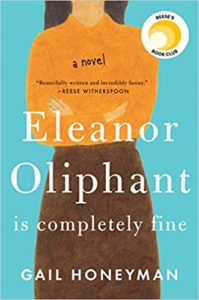I was heart crushed to learn from my brother-in-law (of all people) that the “Stella Awards” that I passed on to you last week are… well… fake news. Though the Stella Liebeck case that they are based on is real, there is no organization presently giving out awards for amazingly ridiculous litigation results. There should be, because there are plenty of stupendously stupid adjudications. Alas, there isn’t. Maybe one day I’ll find the time to promote a verifiable version of the Stella Awards. In the meantime, we’ll have to be satisfied with the fake ones.

Want to Be a Good Writer? It Isn’t Easy, but This Is the First Step
“Every discourse, even a poetic or oracular sentence, carries with it a system of rules for producing analogous things and thus an outline of methodology.”
– Jacques Derrida
When writers discuss their craft, the conversation is often about larger issues – like structuring a plot or developing characters… connecting thoughts and weaving themes… creating tension and anticipation… and the architecture of persuasion.
But we seldom talk about the first and foremost challenge: how to write a good sentence.
Hemingway famously said, “All you have to do is write one true sentence. Write the truest sentence that you know.”
I’ve never heard a good writer dispute this.
In Several Short Sentences About Writing, Verlyn Klinkenborg – one of my favorite writers about writing – says there is a reason the sentence must come first:
“Your job as a writer is making sentences. Most of your time will be spent making sentences in your head. In your head. Did no one ever tell you this? That is the writer’s life.”
Most of the sentences that beginning writers write, he warns, will not be worth keeping. “You will have to delete them. And most of the rest of your sentences will have promise, but they will need fixing. The hard part now is deciding which to kill and which to fix and how to fix them.”
This is a skill. A skill that the writer can never completely master.
He continues:
“A writer’s real work is the endless winnowing of sentences. The relentless exploration of possibilities, the effort, over and over again, to see in what you started out to say the possibility of saying something you didn’t know you could.”
If that sounds like hard work, it is. But if you learn to write a single good sentence, you can writer another, and then another still.
“Shape, form, structure, genre, the whole – these have a way of clarifying themselves when the sentences become clear,” Klinkenborg says. “Once you can actually see your thoughts as perceptions, it’s surprising how easy it is to arrange them or discover their arrangement. This always comes as a revelation.”
What is a good sentence?
It’s impossible to define exactly what a good sentence is because good sentences are ephemeral things. A sentence is not a block of meaning alongside of which one can lay down other blocks to form paths of thought. Nor can they be stacked upon one another to build plots and themes.
A sentence is a mercurial organism that morphs – and should morph – into whatever shape its environment needs it to be.
Sentences can be units of thoughts, as my first grammar book defined them. But they don’t have to be. They can be partial thoughts. Or mere fragments of thoughts. Or sometimes… just… words.
Good sentences are never inert. They are active. They have jobs to do. They can tell. They can show. They can explain. They can surprise. They can delight. And so much more.
We live in a digital world that has democratized just about everything, including the practice and profession of writing. The worldwide web has expanded the population of writers a thousandfold or more.
But writing and writing well are two very different things. And the difference between a writer and a good writer is easy to tell. Good writers aren’t content with disgorging their thoughts and feelings. They are happy only when their sentences work well.
“My Writing Time Is Sacred, but Please Don’t Ask Me What I Did All Day”
Brevity is a “non-fiction blog” that profits from giving wannabe writers a platform to write about how they wannabe writers.
It irks me (as an entrepreneur) because it’s such a clever idea. “For a modest subscription fee,” Brevity proclaims, “you can now consider yourself an actual writer by sending us the occasional note about your struggle to get published or simply to get some writing done.”
Its subscribers are mostly “memoirists” – i.e., people that believe they have “a book inside” them.
This is a large audience. In the US, I’m guessing it’s about 30 million.
So kudos to Brevity for pandering to this audience.
As someone that actually writes for a living, however, Brevity irks me in another way, which is humorously expressed in this essay, published in Brevity, but written by an actual writer.
There’s no end to human creativity. JM sent these images of a new trend in street art: painted stairs.
In Philadelphia…

In Tokyo, Japan…

In Poznan, Poland…

In Seoul, South Korea…


Eleanor Oliphant Is Completely Fine
By Gail Honeyman
352 pages
Published in 2017 by Penguin Books
The plot of Eleanor Oliphant Is Completely Fine is almost a cliché of romance novels and high school movies – the neglected and sometimes shunned Plain Jane that blooms as she opens herself up to love.
That may be too harsh. It might be better to say that in writing Eleanor Oliphant Is Completely Fine, Gail Honeyman works from a relatively recent sub-genre that is best exemplified by the “Bridget Jones” novels.
But I’m happy to say that there is a lot more going on than just that.
The main character, for one. The novel is written in the first person. Eleanor, the narrator, begins her story without any sense of how she sounds or appears. She is intelligent and well educated. She is also extremely judgmental. Her sheltered childhood has traumatized her to the point that she seems like a Victorian woman with Asperger’s transported into the 20th century. It is this perspective that makes her lovable and relatable and provides for a stream of laugh-out-loud interchanges throughout the book.
There is also quite a bit of satire throughout – targeting everything from office politics to wedding rituals to hipster clothing and bikini waxes. And there is a darker story that runs behind it – of childhood and other abuse. But to Honeyman’s credit, this is never overdone. It adds some depth, but no more than the plot could bear.
I wouldn’t call Eleanor Oliphant Is Completely Fine a novel for the ages – but at the least, it is smartly funny entertainment, and at its best it reminded me of a Jane Austen novel. Which is about as good as novel writing gets.
Critical Reviews
“A charmer… satisfyingly quirky.” (Janet Maslin in The New York Times)
“This wacky, charming novel… draws you in with humor, then turns out to contain both a suspenseful subplot and a sweet romance…. Hilarious and moving.” (People)
“Sweet and satisfying, Eleanor Oliphant Is Completely Fine will speak to introverts who have ever felt a little weird about their place in the world.” (Bustle)
“Debut author Honeyman expertly captures a woman whose inner pain is excruciating and whose face and heart are scarred, but who still holds the capacity to love and be loved. Eleanor’s story will move readers.” (Publishers Weekly)

Operation Finale (2018) on Netflix
Directed by Chris Weitz
Starring Ben Kingsley, Oscar Isaac, and Lior Raz
Operation Finale – considered to be a remake of the 1979 film The House on Garibaldi Street – is based on a true story: In the 1960s, a group of Israeli Mossad officers traveled to Argentina to find and capture Adolph Eichmann, “the architect of the Final Solution,” and bring him to Israel, where he would be tried publicly for his war crimes. (Mossad is the national intelligence agency of Israel.)
Why I watched it: It provides some insights into something I was always fascinated by, but never researched: the community of Nazis that fled to Argentina after WWII.
What I doubted: Although based on real events, some elements of the plot seemed unlikely. I suspect they were introduced to increase the suspense.
What I believed: During his week-long interrogation, Eichmann was not responsive to the intimidation of five of his six interlocutors, but yielded finally to the softer approach of the sixth. This corresponds to what I’ve read about the ineffectiveness of torture as a method of interrogation.
What was brave about it: It addresses the question of whether a soldier has responsibility over and culpability for his actions during a war – and if so, to what extent. (The same theme was explored in The Spy Who Came in From the Cold.)
What was not so brave about it: In this case, the soldier in question was Adolph Eichmann. His defense – that he was just following orders – was presented, but without strength behind it. It was a straw-man defense, too easily pushed over. That can work in terms of the horizontality of the plot (the bad guy gets his just deserts), but it didn’t work on a philosophical level. I found myself wishing that the character had been given more and better lines, so that the antithetical argument could have been more strongly argued.
Interesting Facts
* While filming, Ben Kingsley kept a photo of Holocaust survivor Elie Wiesel on set to remind himself of his responsibility for historical accuracy. He also did this while filming Schindler’s List, but with a photo of Anne Frank.
* Hannah Arendt, a film about the life of the German-Jewish philosopher, picks up where Operation Finale leaves off and offers an in-depth look at Eichmann’s trial from Arendt’s perspective.
Critical Reviews
* “As a more complete retelling of a particular moment of history… the film is a diverting watch, anchored with enough of Weitz’s intriguing personal touches to keep it from feeling like a glorified History Channel special.” (The Atlantic)
* “Despite clichéd depictions of Nazi atrocities, the movie persuasively evokes, with its wealth of details, the slender threads on which historical events – and historical truth – depend.” (The New Yorker)
* “A well-made spy thriller replete with scenes of secret surveillance, faked passports, and hairbreadth escapes.” (Seattle Times)
You can watch the trailer here.
This homeless ex-marine can still tickle the ivories…

Paradise Palms, my botanical garden in Delray Beach, must be home to a thousand iguanas. They are not particularly good-looking creatures. Some can be downright weird. And big. They can grow to four feet.
But they pose no immediate danger to small dogs and toddlers, as the alligators do. We hunt and kill the alligators, but since iguanas are herbivores, we let them do their thing.
Iguanas are one of many invasive species that are multiplying exponentially here in my home state of Florida. We also have exploding populations of pythons, cane toads, lionfish, and giant African land snails – to name just a few!
Should we, as suggested by a recent article in National Geographic, fight back in what it calls “an extremely Florida war”? Or should we shrug it off? (As JS says, “Hey! If you live in a jungle, you have to expect this sort of thing!”)
The Not-So-Free Press
I’ve been in the business of selling newsletters by subscription since my Peace Corps days. The subscription business was always bigger than the general advertising business, but nobody knew it. When the internet became the thing around 2000, we changed from 90% paper to 90% digital in just a few years, but we continued with the subscription model because we realized it was perfect for digital marketing. And digital marketing was growing like crazy.
Since then, we’ve gradually seen our publishing competitors (newspapers and magazines) gradually shift from relying on advertising to subscription models.
The Wall Street Journal was one of the first major news sites to put up a “paywall” (as it’s called). Reuters, one of the world’s largest news publishers, is the latest.
According to an article from The Daily Upside that BK forwarded to me, they are relaunching their website to focus on business and financial news… and asking their readers to pay for it. (“It seems,” says BK, “like the media world is still trying to figure out what you guys figured out years ago.”)
After a “preview period” of 5 free articles a month, digital subscribers will pay $34.99. That’s what Bloomberg, Reuters’ main rival, has been charging – and Bloomberg expects to reach about 400,000 consumer subscriptions this year, up from 250,000 last year. The WSJ charges $38.99, and the NYT charges $18.42.
The article points out that “the ‘professional’ audience (aka, those with a corporate expense account) is a lucrative audience to target. And many publishers are beginning to see the value of stable subscription revenue…. In 2020, subscription news revenue grew 16% even as advertising revenues slumped heavily amid the pandemic. Overall, the subscription news economy has grown by nearly 500% in the past decade.”
Have you heard of the Stella Awards?
I hadn’t… until one of my high school buddies clued me in. They are named in honor of Stella Liebeck, the 79-year-old woman that sued McDonald’s after she spilled hot coffee on herself and suffered third-degree burns. Apparently, she took the lid off the coffee and put it between her knees while she was driving. Amazingly, she won her case.
These are the top 5 Stella Award winners for 2020:
5th PLACE – Terrence Dickson, of Bristol, PA, was leaving a house he had just burglarized by way of the garage. Unfortunately for Dickson, the automatic garage door opener malfunctioned and he could not get the door to open. Worse, he couldn’t re-enter the house because the door connecting the garage to the house locked when he pulled it shut. Forced to sit for eight, count ‘em, EIGHT days and survive on a case of Pepsi and a large bag of dry dog food, he sued the homeowner’s insurance company, claiming undue mental anguish. The jury found in his favor, ordering the insurance company to pay Dickson $500,000 for his anguish.
4th PLACE – Jerry Williams, of Little Rock, AR, was awarded $14,500 plus medical expenses after being bitten on the butt by his neighbor’s beagle – even though the dog was on a chain in its owner’s fenced yard. Williams did not get as much as he asked for because the jury believed the dog might have been provoked at the time of the butt bite because Williams had climbed over the fence into the yard and repeatedly shot it with a pellet gun.
3rd PLACE – Amber Carson, of Lancaster, PA, because a jury ordered a Philadelphia restaurant to pay her $113,500 after she slipped on a spilled soft drink and broke her tailbone. The reason the soft drink was on the floor: Ms. Carson had thrown it at her boyfriend 30 seconds earlier during an argument.
2nd PLACE – Kara Walton, of Claymont, DE, sued the owner of a nightclub in a nearby city because she fell from the bathroom window to the floor, knocking out her two front teeth. Even though Ms. Walton was trying to sneak through the window to avoid paying the $3.50 cover charge, the jury said the nightclub had to pay her $12,000… oh, yeah, plus dental expenses.
1st PLACE – This year’s runaway Stella Award winner was Mrs. Merv Grazinski, of Oklahoma City, OK. On her way home after purchasing a new 32-foot Winnebago motor home, she set the cruise control at 70 mph and left the driver’s seat to go to the back of the Winnebago to make herself a sandwich. Not surprisingly, the motor home left the freeway, crashed, and overturned. Mrs. Grazinski sued Winnebago for not putting in the owner’s manual that she couldn’t leave the driver’s seat while the cruise control was set. The Oklahoma jury awarded her $1,750,000. PLUS a new motor home. (Winnebago actually changed the wording in its manuals as a result of this suit.)
